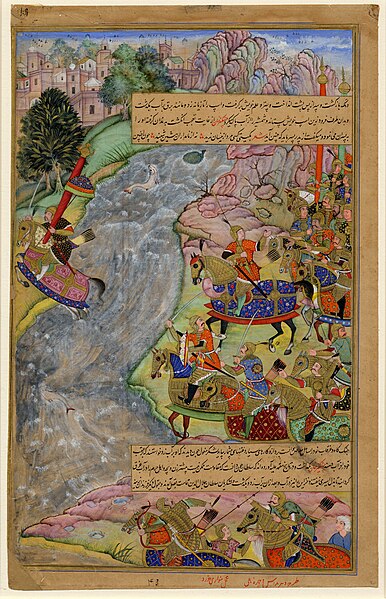The Battle of the Indus was fought on the banks of the Indus River, on 24 November 1221, by two armies commanded by Shah Jalal al-Din Mingburnu of the Khwarazmian Empire, and Genghis Khan of the Mongol Empire. The battle, which resulted in an overwhelming Mongol victory, was the concluding engagement in the Mongol conquest of the Khwarazmian Empire.
Late 16th-century depiction of Jalal al-Din fleeing the battle by crossing the Indus; Genghis Khan looks on.
Mid-16th century depiction Jalal al-Din Khwarazmshah crossing the rapid Indus River, escaping Genghis Khan and his army
Jalal al-Din Mangburni, also known as Jalal al-Din Khwarazmshah, was the last Khwarazmshah of the Anushteginid dynasty. The eldest son and successor of Ala ad-Din Muhammad II of the Khwarazmian Empire, Jalal al-Din was brought up at Gurganj, the wealthy capital of the Khwarazmid homeland. An able general, he served as second-in-command to his father in at least one battle; however, since he was the son of a concubine, he was challenged as successor by a younger brother, whose cause was supported by the powerful Queen Mother, Terken Khatun. Nevertheless, after the Mongol conquest of the Khwarazmian Empire led to his father's flight and death on an island in the Caspian Sea, Jalal-al Din gained the loyalty of the majority of Khwarazmian loyalists.
Uzbek 25 soʻm coin commemorating Jalal al-Din
Battle of the Indus: Jalal al-Din Khwarazm-Shah crossing the rapid Indus River on horseback, escaping Genghis Khan and the Mongol army.
Coinage of Jalal al-Din Mangubarni. AR Double Dirham. Qal 'a Nay mint
The Georgians (left) against the Khwarezmians (right) in the battle of Bolnisi in 1227. From the Tarikh-i Jahangushay manuscript created in Shiraz, Iran, in 1438.





